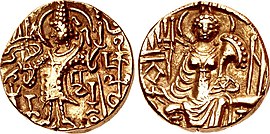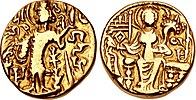Kushan Ruler
| Kipunada | |
|---|---|
| Kushan Ruler | |
 Coin of Kipunada. Circa 335-350 CE. Coin of Kipunada. Circa 335-350 CE.Obverse: Kipunada standing left, sacrificing over altar. To the right, name vertically in Brahmi script in monogrammic form: Ki-pu-ṇa Under the ruler's arm: Bacharnatha Reverse: Ardoxsho enthroned facing, holding investiture garland and cornucopia. | |
| Reign | 335-350 CE |
| Coronation | 335 CE |
| Predecessor | Shaka I |
| Successor | Kidarites |
| Born | 297 CE |
| Burial | 350 CE |
| Kushan emperors 30 CE–350 CE | ||||||||||||||||||||||||||||||
|---|---|---|---|---|---|---|---|---|---|---|---|---|---|---|---|---|---|---|---|---|---|---|---|---|---|---|---|---|---|---|
|
||||||||||||||||||||||||||||||
Kipunada (Brahmi script: ![]()
![]()
![]() Ki-pu-ṇa-dha), also Kipanadha, was probably the last ruler of the Kushan Empire around 335-350 CE. He is known for his gold coinage. He succeeded Shaka I. Kipunada was probably only a local ruler in the area of Taxila, in western Punjab, and he may have been a subject of Gupta Emperor Samudragupta.
Ki-pu-ṇa-dha), also Kipanadha, was probably the last ruler of the Kushan Empire around 335-350 CE. He is known for his gold coinage. He succeeded Shaka I. Kipunada was probably only a local ruler in the area of Taxila, in western Punjab, and he may have been a subject of Gupta Emperor Samudragupta.
Gupta and Kidarite successors
The coins of Kipunada in Central and Western Punjab were followed by peculiar coins minted locally in Punjab, with the name "Samudra" on them (Gupta script:![]()
![]()
![]() ), presumably connected to the Gupta Empire ruler Samudragupta. Soon after this, coinage was issued in Punjab by Kidarite Hun rulers known as Kirada, Peroz and then the famous Kidara, who occupied the territory formerly held by the Kushans.
), presumably connected to the Gupta Empire ruler Samudragupta. Soon after this, coinage was issued in Punjab by Kidarite Hun rulers known as Kirada, Peroz and then the famous Kidara, who occupied the territory formerly held by the Kushans.
-
 Local coin minted in the Punjab area with the name "Samudra" (
Local coin minted in the Punjab area with the name "Samudra" (

 Sa-mu-dra, under the king's left arm), presumably Samudragupta, immediately followed those of Kipunada.
Sa-mu-dra, under the king's left arm), presumably Samudragupta, immediately followed those of Kipunada.
-
 The next coins were those of Kidarite Hun kings, starting with Kirada (
The next coins were those of Kidarite Hun kings, starting with Kirada (

 Ki-ra-da under the king's left arm), who ruled circa 350 CE.
Ki-ra-da under the king's left arm), who ruled circa 350 CE.
| Preceded byShaka I | Kushan Ruler c. 335-350 CE |
Succeeded byGupta Empire/ Kidarites (Kirada) |
Notes
- CNG Coins
- ^ Cribb, Joe; Donovan, Peter (2014). Kushan, Kushano-Sasanian, and Kidarite Coins A Catalogue of Coins From the American Numismatic Society by David Jongeward and Joe Cribb with Peter Donovan. p. 4.
- Heritage World Coin Auctions Long Beach Signature Auction Catalog #378. Ivy Press. May 2005. p. 15. ISBN 978-1-932899-79-5.
- Rezakhani, Khodadad (2017). From the Kushans to the Western Turks. p. 203.
- ^ Cribb, Joe. "The Kidarites, the numismatic evidence.pdf". Coins, Art and Chronology II, Edited by M. Alram et Al.: 101.
- ^ "In the Punjab the stylistic progression of the gold series from Kushan to Kidarite is clear: imitation staters were issued first in the name of Samudragupta, then by Kirada, 'Peroz' and finally Kidara" in Errington, Elizabeth; Curtis, Vesta Sarkhosh (2007). From Persepolis to the Punjab: Exploring Ancient Iran, Afghanistan and Pakistan. British Museum Press. p. 88. ISBN 978-0-7141-1165-0.
- Rezakhani, Khodadad (2017). ReOrienting the Sasanians: East Iran in Late Antiquity. Edinburgh University Press. p. 85. ISBN 978-1-4744-0030-5.
External links
This biography of a member of an Asian royal house is a stub. You can help Misplaced Pages by expanding it. |

